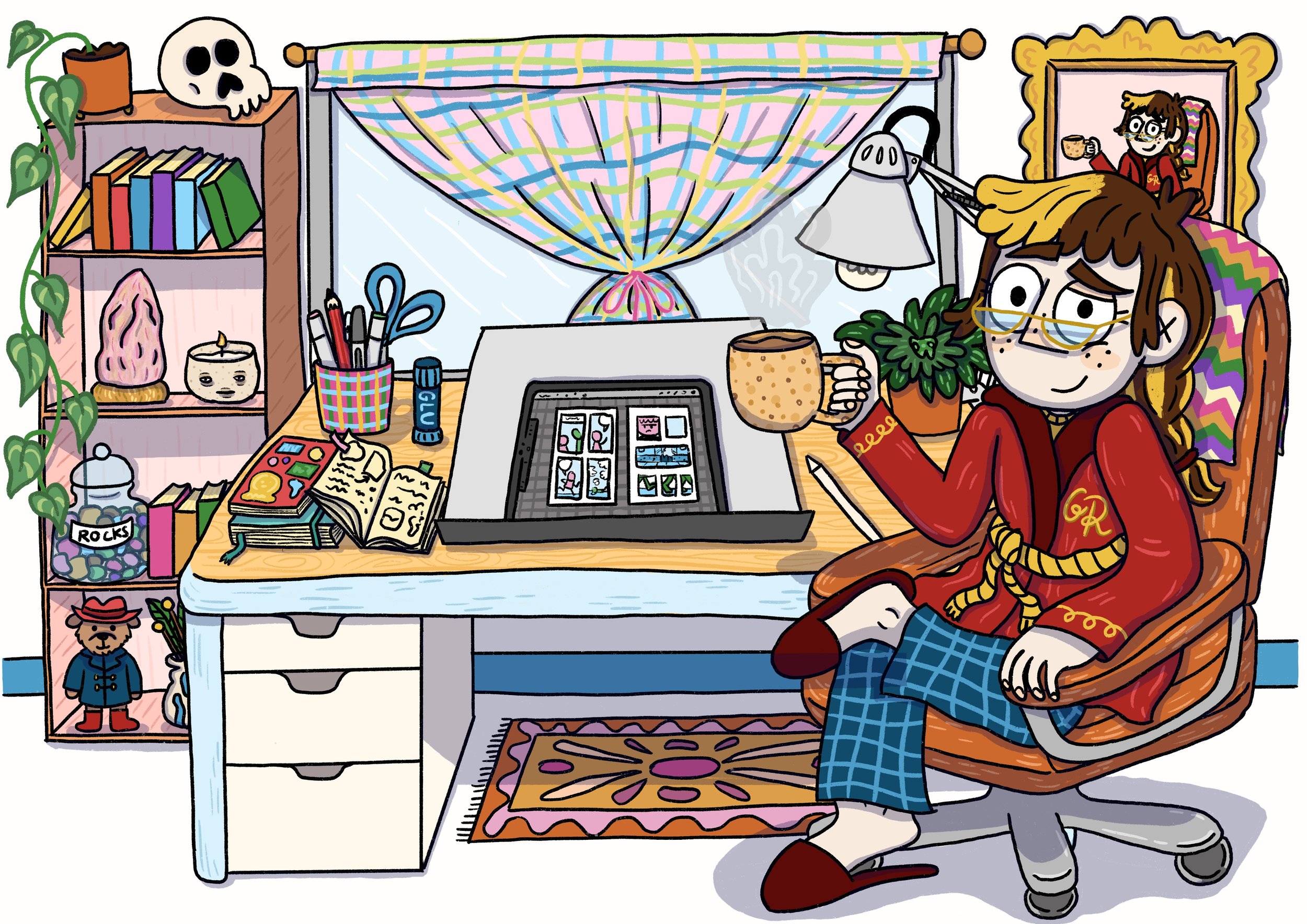In June I went to Wollongong for the first time. I travelled by myself (which is very nerve-wracking for me) and managed to get safely to Thirroul (near Wollongong, NSW). I was visiting my mentor Pat Grant. For two whole weeks we would be hanging out, talking about my graphic novel and pulling apart my script. I was thrilled and terrified all at once (a fairly normal feeling for me).
I kept a comics journal of my time there, which I've included a few pages from in this blog (the pictures in blue).
We spent the first week in Pat's studio, chatting about comics and life. I felt overwhelmed and like I would never know how to answer his questions. I assumed I would sit in mute silence for the whole two weeks.
Luckily, I loosened up after the first week and we got quite of a lot script rewriting and pulling apart done.
Pat asked me lots of questions, some easy and some hard. Not just about comics but life in general too (work, kids, Owen). I think my brain is still trying to process some of them.
One of the best things I got out of the trip was the insight into how Pat pulls apart a script and turns written words and thoughts into a comics page. Having never written anything longer than about 38 pages (and that was a comic journal and doesn't really count as a planned out script), I was dubious about whether or not I could actually write something long-form. I didn't know where to start, let alone what process to take. So Pat taught me how he does his thumbnails and the first week all I did was drink turmeric lattes and draw thumbnails.
Pat's thumbnailing technique really helped me and I was hooked after translating the first couple of scenes from the rough script into rough illustrated panels. By the end of the first week I had a complete script and thumbnails to take home and draw up into a rough draft manuscript (more on that in a later post).
I had a couple of day trips to Sydney where I spent too much money on bubble tea and a new backpack. I found the most amazing book store, Kinokuniya - their comic section alone could rival some comic stores I've been to.
I also got to visit a wicked offset press printer that one of my hosts from my host family helps to run. It was pretty neat. You should look up the stuff they do.
In the second week Pat wanted to do some more drawing type skills (which I was totally keen for as I think that a few of my weak points are watercolouring and scene illustrations). So one night Pat came over to where I was staying, bearing hot soup and a bunch of watercolour paints. We each drew a colour-in page for the other and then, working with a limited palette, coloured the other person's illustrations. It was super fun and for me it's the best way to learn: have someone right there telling me what they do and explaining how I could do it too. Also physically colouring at the same time helped. I can't learn something by reading the theory. It doesn't sink into my brain until I do it with my hands.
For those who don't know, Pat is a radical someone in the Australian comics field that I've looked up to since I first read his book Blue several years ago. Having the chance to work with him on one of my projects and learn the tricks of the trade is one of those dream-come-true moments. So when Pat suggested that we do a little drawing project while I was hanging out in the Gong, I tried to hide my pure excitement.
The idea was that we would both walk around the neighbourhood together for a day and draw scenes of the area.
We would take turns in picking a place to draw and alternate who drew each panel. It was awesome. I particularly liked this as I've always wanted to be better at drawing scenery and backgrounds. In particular I've wanted to make my comics look Australian.
This walk and draw inspired me to go out and draw in the real world and not just stay at my desk trying to remember what places looked like.
On the whole, the trip was great! Which I knew it would be once I stopped being my normal Nervous Nelly self. It was pretty exciting to think that over the two weeks I'd learnt some tips on watercolours, scenery, and making things Australian. I started to think about lots of things I normally wouldn't and learnt new ways to think critically about my own work. And I wrote a third of my book and I was pretty happy with it.
Unfortunately, as often happens, I got sick on the last day and boy was that plane ride home the worst. Although, even the airport had a great message of encouragement for me.
I know I have a long way to go but it feels so much more achievable now. I have a process that I enjoy and that works and now all I have to do is do it.
If you want to read more about my travels in The Gong you can buy physical copies of my journal comic at my Etsy store here.
That's it for this post but in the next couple of posts I'll pull apart how I've been working this past month on my first draft manuscript. Eeep!
xx



































































































